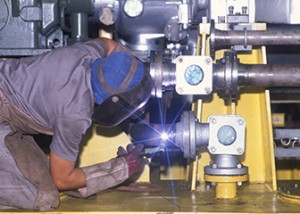Energy Efficiency Jobs
Boilermakers are critical to the creation of green energy technologies and environmental improvements of existing technologies.
Boilermakers are critical to the creation of green energy technologies and environmental improvements of existing technologies.
Boilermakers work on constructing, assembling, installing, and repairing boilers, tanks, vats, stationary steam boilers and boiler house auxiliaries. Boilers are used in many buildings, factories, and ships to heat water under extreme pressure to generate electric power and to provide heat. Boilers are made from steel, iron, copper, or stainless steel with some automation during production, however, a lot of works still need to be done by hand by these green job holders.
 Boilermakers examine boilers, pressure vessels, tanks, or vats to locate defects, such as leaks, weak spots, or defective sections which can cause serious operational problems. They often use blueprints to determine the location, position, or dimensions of the associated parts. Boilermakers frequently use hand or power tools and in some cases flame cutting torches to fashion pieces for a boiler. Other common tools include: plumb bobs, levels, wedges, and turnbuckles to bend pieces and line them up with adjoining components. They use wrenches or welding equipment to bolt or weld pressure vessel parts together. Lastly, they use hand tools to install manholes, taps, tubes, valves, gauges, and feed water connections in drums of water tub boilers.
Boilermakers examine boilers, pressure vessels, tanks, or vats to locate defects, such as leaks, weak spots, or defective sections which can cause serious operational problems. They often use blueprints to determine the location, position, or dimensions of the associated parts. Boilermakers frequently use hand or power tools and in some cases flame cutting torches to fashion pieces for a boiler. Other common tools include: plumb bobs, levels, wedges, and turnbuckles to bend pieces and line them up with adjoining components. They use wrenches or welding equipment to bolt or weld pressure vessel parts together. Lastly, they use hand tools to install manholes, taps, tubes, valves, gauges, and feed water connections in drums of water tub boilers.
As part of their job, boilermakers install small premade boilers into buildings and factories. If the parts or plate sections are very large, they may use large cranes to lift these parts into place. Once the parts are lined up the parts, they use metalworking machines and tools to remove rough edges and join them by bolting, welding or riveting the components. Often robotic or automatic welders are used to assemble boiler tanks. Boilermakers must regularly maintain and upgrade parts for a boiler. This is done by frequently inspecting tubes, fittings, safety and check valves, boiler controls, auxiliary mechanisms, feed pumps, water and pressure gauges.
These green job holders often go past just boilers alone, expanding their skills into other areas. Boilermakers will repair air pollution equipment to help control the discharge of hazardous waste into the environment. Additionally, they may also repair blast furnaces, water treatment plants and smokestacks. Some boilermakers install and maintain the pipes used in dams to send water to and from hydroelectric power generation turbines which is the most widely used form of renewable energy.
Boilermakers usually perform physically demanding work and operate dangerous equipment. They will often need to work outdoors in all kinds of weather, including extreme hot and cold conditions. These green careers usually call for working at great heights since boilers, pressure vessels, and storage tanks are usually very large. Boilermakers also need to work in cramped spaces inside boilers, tanks and vats. It is important to note that boilermakers have a lower rate of injuries and illness than many other construction jobs. Boilermakers often are required to travel to worksites and may have to work overtime when maintaining or repairing equipment
Most boilermakers usually enter this green career with a high school diploma and through a formal 4-5 year apprenticeship program. There are 4 recognized apprenticeable specialties associated with this occupation: Boiler House Mechanic, Boilermaker Fitter, Boilermaker I and Boilermaker II. Those who have welding experience or welding certifications are more likely to get into these training programs. With technical training, they learn about basic mathematics, blueprint reading and sketching, metal and installation techniques, safety practices and constructions techniques. With on-the-job training, boilermakers will learn to use the tools and equipment of the trade. Candidates with welding certificate or welding experience have advantage over those without experience or certification.
The Bureau of Labor Statistics (BLS) expects employment of this field to grow 21 percent from 2010 until 2020; this is faster than the average for all green jobs. The need to continuously upgrade and replace parts for boilers stimulates demands for boilermakers. Also, to satisfy the requirements of the Clean Air Act, utility companies need to continue upgrading their boilers and scrubbing systems which further drives the demands for boilermaker jobs. The BLS projected 20,000 boilermaker job openings between 2010 and 2020, and noted 11,800 jobs are currently filled. Titles included Boiler Maker, Boilermaker, Boilermaker Mechanic, Service Technician, Boiler Technician, Boiler Mechanic, Boilermaker Pipe Fitter, Boiler Welder, and Boilermaker Welder. The BLS further reports that the median annual wage for salaried boilermakers was $56,910 in 2011 with median hourly wage of $27.36. The lowest 10 percent earned less than $30,410, and the top 10 percent earned more than $80,830.